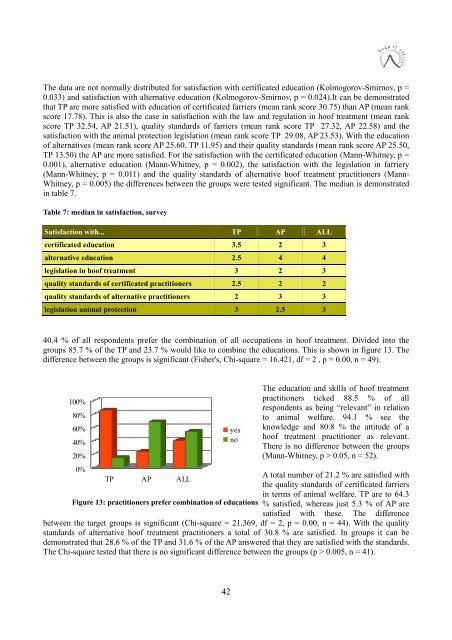Bachelor Thesis - Christina Kuenen - Hufpfleger
Bachelor Thesis - Christina Kuenen - Hufpfleger
Bachelor Thesis - Christina Kuenen - Hufpfleger
You also want an ePaper? Increase the reach of your titles
YUMPU automatically turns print PDFs into web optimized ePapers that Google loves.
The data are not normally distributed for satisfaction with certificated education (Kolmogorov-Smirnov, p =<br />
0.033) and satisfaction with alternative education (Kolmogorov-Smirnov, p = 0.024).It can be demonstrated<br />
that TP are more satisfied with education of certificated farriers (mean rank score 30.75) than AP (mean rank<br />
score 17.78). This is also the case in satisfaction with the law and regulation in hoof treatment (mean rank<br />
score TP 32.54, AP 21.51), quality standards of farriers (mean rank score TP 27.32, AP 22.58) and the<br />
satisfaction with the animal protection legislation (mean rank score TP 29.08, AP 23.53). With the education<br />
of alternatives (mean rank score AP 25.60, TP 11.95) and their quality standards (mean rank score AP 25.50,<br />
TP 13.50) the AP are more satisfied. For the satisfaction with the certificated education (Mann-Whitney, p =<br />
0.001), alternative education (Mann-Whitney, p = 0.002), the satisfaction with the legislation in farriery<br />
(Mann-Whitney, p = 0.011) and the quality standards of alternative hoof treatment practitioners (Mann-<br />
Whitney, p = 0.005) the differences between the groups were tested significant. The median is demonstrated<br />
in table 7.<br />
Table 7: median in satisfaction, survey<br />
Satisfaction with... TP AP ALL<br />
certificated education 3.5 2 3<br />
alternative education 2.5 4 4<br />
legislation in hoof treatment 3 2 3<br />
quality standards of certificated practitioners 2.5 2 2<br />
quality standards of alternative practitioners 2 3 3<br />
legislation animal protection 3 2.5 3<br />
40.4 % of all respondents prefer the combination of all occupations in hoof treatment. Divided into the<br />
groups 85.7 % of the TP and 23.7 % would like to combine the educations. This is shown in figure 13. The<br />
difference between the groups is significant (Fisher's, Chi-square = 16.421, df = 2 , p = 0.00, n = 49).<br />
100%<br />
80%<br />
60%<br />
40%<br />
20%<br />
The education and skills of hoof treatment<br />
practitioners ticked 88.5 % of all<br />
respondents as being “relevant” in relation<br />
to animal welfare. 94.1 % see the<br />
knowledge and 80.8 % the attitude of a<br />
hoof treatment practitioner as relevant.<br />
There is no difference between the groups<br />
(Mann-Whitney, p > 0.05, n = 52).<br />
0%<br />
A total number of 21.2 % are satisfied with<br />
TP AP ALL<br />
the quality standards of certificated farriers<br />
in terms of animal welfare. TP are to 64.3<br />
Figure 13: practitioners prefer combination of educations % satisfied, whereas just 5.3 % of AP are<br />
satisfied with these. The difference<br />
between the target groups is significant (Chi-square = 21.369, df = 2, p = 0.00, n = 44). With the quality<br />
standards of alternative hoof treatment practitioners a total of 30.8 % are satisfied. In groups it can be<br />
demonstrated that 28.6 % of the TP and 31.6 % of the AP answered that they are satisfied with the standards.<br />
The Chi-square tested that there is no significant difference between the groups (p > 0.005, n = 41).<br />
yes<br />
no<br />
42


